Early Childhood Education: Mandela's Portrait in Long Walk to Freedom
VerifiedAdded on 2023/06/15
|10
|3353
|447
Essay
AI Summary
This essay explores the contexts and characteristics of childcare, drawing insights from Idris Elba's portrayal of Nelson Mandela in 'Long Walk to Freedom.' It examines Mandela's childhood in Qunu and Mqhekezweni, highlighting the influence of culture, family values, and religion on his development. The analysis discusses the importance of moral upbringing, peer interaction, and responsive parenting, contrasting Mandela's experiences with the challenges faced by children during the apartheid era. The reflection emphasizes the impact of parenting styles on a child's ability to form relationships, mental health, and self-esteem, ultimately advocating for providing children with the best possible care and guidance.
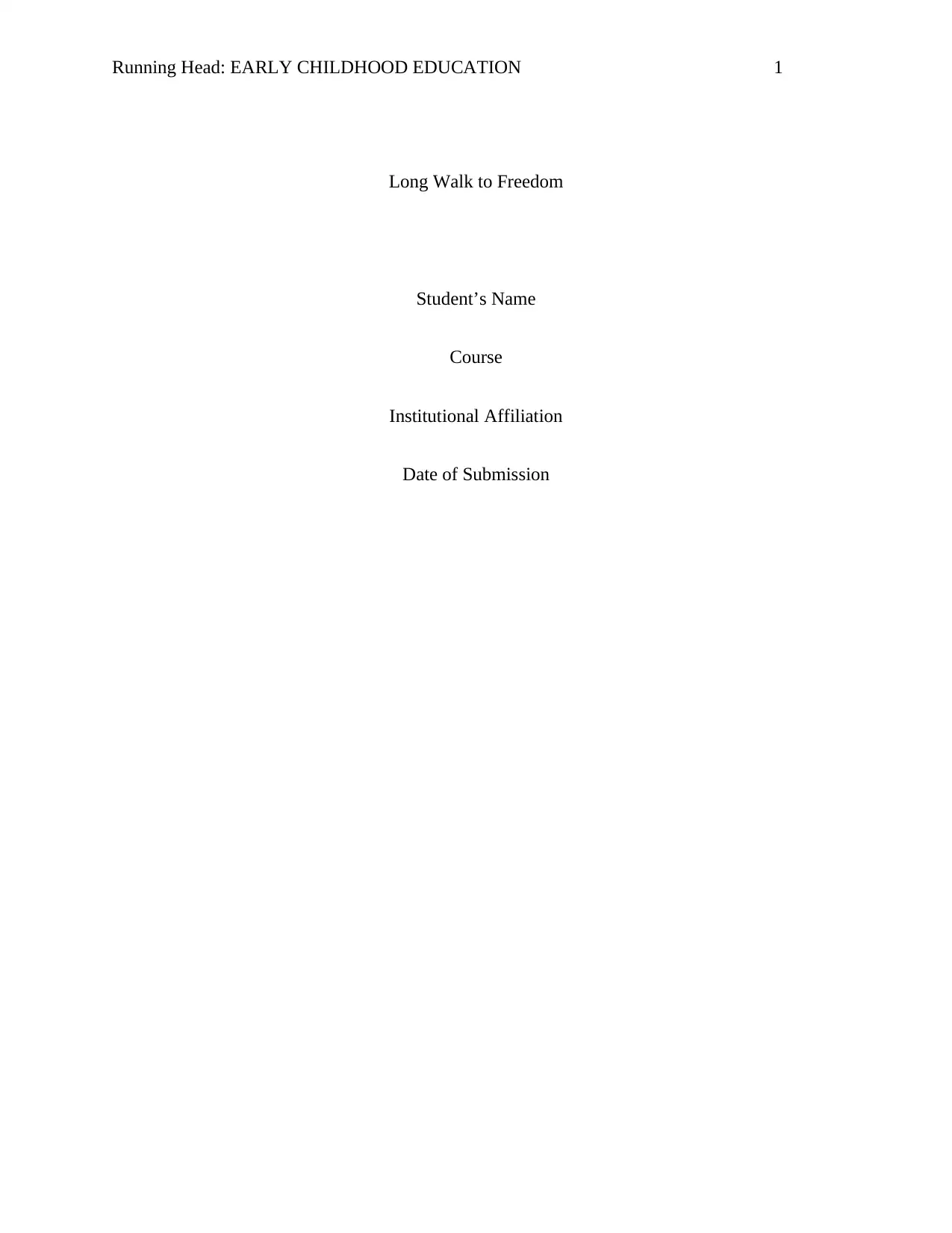
Running Head: EARLY CHILDHOOD EDUCATION 1
Long Walk to Freedom
Student’s Name
Course
Institutional Affiliation
Date of Submission
Long Walk to Freedom
Student’s Name
Course
Institutional Affiliation
Date of Submission
Paraphrase This Document
Need a fresh take? Get an instant paraphrase of this document with our AI Paraphraser
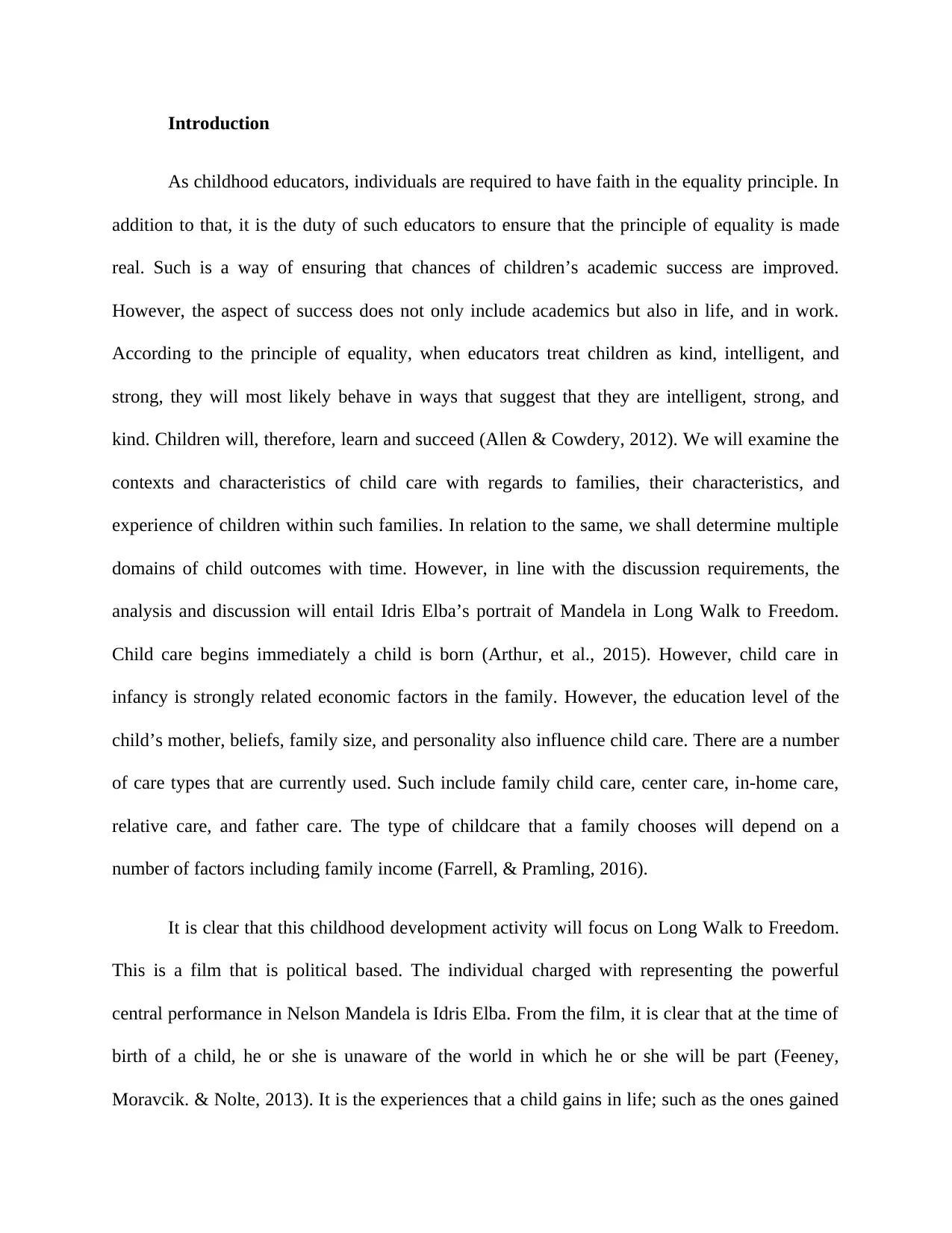
Introduction
As childhood educators, individuals are required to have faith in the equality principle. In
addition to that, it is the duty of such educators to ensure that the principle of equality is made
real. Such is a way of ensuring that chances of children’s academic success are improved.
However, the aspect of success does not only include academics but also in life, and in work.
According to the principle of equality, when educators treat children as kind, intelligent, and
strong, they will most likely behave in ways that suggest that they are intelligent, strong, and
kind. Children will, therefore, learn and succeed (Allen & Cowdery, 2012). We will examine the
contexts and characteristics of child care with regards to families, their characteristics, and
experience of children within such families. In relation to the same, we shall determine multiple
domains of child outcomes with time. However, in line with the discussion requirements, the
analysis and discussion will entail Idris Elba’s portrait of Mandela in Long Walk to Freedom.
Child care begins immediately a child is born (Arthur, et al., 2015). However, child care in
infancy is strongly related economic factors in the family. However, the education level of the
child’s mother, beliefs, family size, and personality also influence child care. There are a number
of care types that are currently used. Such include family child care, center care, in-home care,
relative care, and father care. The type of childcare that a family chooses will depend on a
number of factors including family income (Farrell, & Pramling, 2016).
It is clear that this childhood development activity will focus on Long Walk to Freedom.
This is a film that is political based. The individual charged with representing the powerful
central performance in Nelson Mandela is Idris Elba. From the film, it is clear that at the time of
birth of a child, he or she is unaware of the world in which he or she will be part (Feeney,
Moravcik. & Nolte, 2013). It is the experiences that a child gains in life; such as the ones gained
As childhood educators, individuals are required to have faith in the equality principle. In
addition to that, it is the duty of such educators to ensure that the principle of equality is made
real. Such is a way of ensuring that chances of children’s academic success are improved.
However, the aspect of success does not only include academics but also in life, and in work.
According to the principle of equality, when educators treat children as kind, intelligent, and
strong, they will most likely behave in ways that suggest that they are intelligent, strong, and
kind. Children will, therefore, learn and succeed (Allen & Cowdery, 2012). We will examine the
contexts and characteristics of child care with regards to families, their characteristics, and
experience of children within such families. In relation to the same, we shall determine multiple
domains of child outcomes with time. However, in line with the discussion requirements, the
analysis and discussion will entail Idris Elba’s portrait of Mandela in Long Walk to Freedom.
Child care begins immediately a child is born (Arthur, et al., 2015). However, child care in
infancy is strongly related economic factors in the family. However, the education level of the
child’s mother, beliefs, family size, and personality also influence child care. There are a number
of care types that are currently used. Such include family child care, center care, in-home care,
relative care, and father care. The type of childcare that a family chooses will depend on a
number of factors including family income (Farrell, & Pramling, 2016).
It is clear that this childhood development activity will focus on Long Walk to Freedom.
This is a film that is political based. The individual charged with representing the powerful
central performance in Nelson Mandela is Idris Elba. From the film, it is clear that at the time of
birth of a child, he or she is unaware of the world in which he or she will be part (Feeney,
Moravcik. & Nolte, 2013). It is the experiences that a child gains in life; such as the ones gained
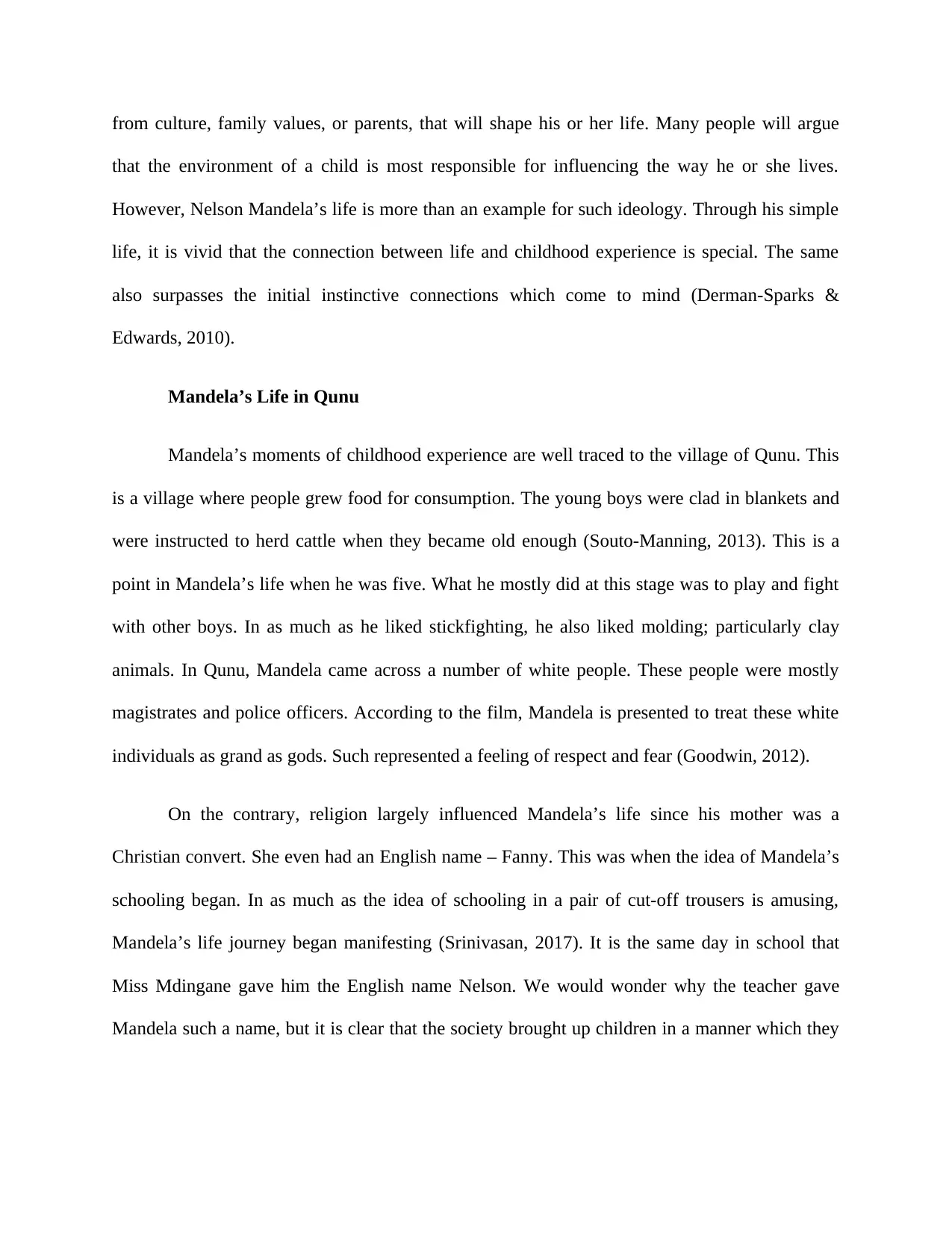
from culture, family values, or parents, that will shape his or her life. Many people will argue
that the environment of a child is most responsible for influencing the way he or she lives.
However, Nelson Mandela’s life is more than an example for such ideology. Through his simple
life, it is vivid that the connection between life and childhood experience is special. The same
also surpasses the initial instinctive connections which come to mind (Derman-Sparks &
Edwards, 2010).
Mandela’s Life in Qunu
Mandela’s moments of childhood experience are well traced to the village of Qunu. This
is a village where people grew food for consumption. The young boys were clad in blankets and
were instructed to herd cattle when they became old enough (Souto-Manning, 2013). This is a
point in Mandela’s life when he was five. What he mostly did at this stage was to play and fight
with other boys. In as much as he liked stickfighting, he also liked molding; particularly clay
animals. In Qunu, Mandela came across a number of white people. These people were mostly
magistrates and police officers. According to the film, Mandela is presented to treat these white
individuals as grand as gods. Such represented a feeling of respect and fear (Goodwin, 2012).
On the contrary, religion largely influenced Mandela’s life since his mother was a
Christian convert. She even had an English name – Fanny. This was when the idea of Mandela’s
schooling began. In as much as the idea of schooling in a pair of cut-off trousers is amusing,
Mandela’s life journey began manifesting (Srinivasan, 2017). It is the same day in school that
Miss Mdingane gave him the English name Nelson. We would wonder why the teacher gave
Mandela such a name, but it is clear that the society brought up children in a manner which they
that the environment of a child is most responsible for influencing the way he or she lives.
However, Nelson Mandela’s life is more than an example for such ideology. Through his simple
life, it is vivid that the connection between life and childhood experience is special. The same
also surpasses the initial instinctive connections which come to mind (Derman-Sparks &
Edwards, 2010).
Mandela’s Life in Qunu
Mandela’s moments of childhood experience are well traced to the village of Qunu. This
is a village where people grew food for consumption. The young boys were clad in blankets and
were instructed to herd cattle when they became old enough (Souto-Manning, 2013). This is a
point in Mandela’s life when he was five. What he mostly did at this stage was to play and fight
with other boys. In as much as he liked stickfighting, he also liked molding; particularly clay
animals. In Qunu, Mandela came across a number of white people. These people were mostly
magistrates and police officers. According to the film, Mandela is presented to treat these white
individuals as grand as gods. Such represented a feeling of respect and fear (Goodwin, 2012).
On the contrary, religion largely influenced Mandela’s life since his mother was a
Christian convert. She even had an English name – Fanny. This was when the idea of Mandela’s
schooling began. In as much as the idea of schooling in a pair of cut-off trousers is amusing,
Mandela’s life journey began manifesting (Srinivasan, 2017). It is the same day in school that
Miss Mdingane gave him the English name Nelson. We would wonder why the teacher gave
Mandela such a name, but it is clear that the society brought up children in a manner which they
⊘ This is a preview!⊘
Do you want full access?
Subscribe today to unlock all pages.

Trusted by 1+ million students worldwide
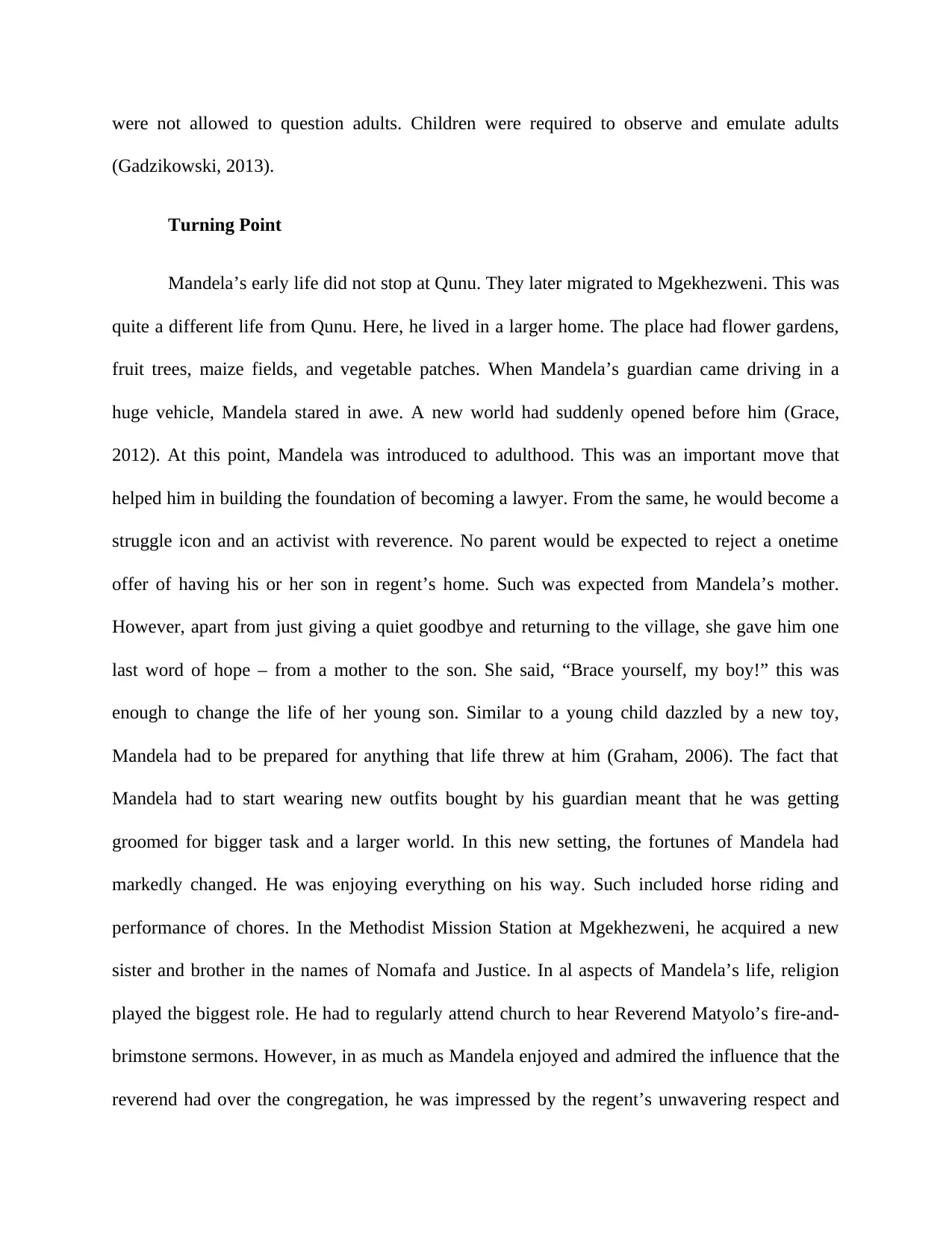
were not allowed to question adults. Children were required to observe and emulate adults
(Gadzikowski, 2013).
Turning Point
Mandela’s early life did not stop at Qunu. They later migrated to Mgekhezweni. This was
quite a different life from Qunu. Here, he lived in a larger home. The place had flower gardens,
fruit trees, maize fields, and vegetable patches. When Mandela’s guardian came driving in a
huge vehicle, Mandela stared in awe. A new world had suddenly opened before him (Grace,
2012). At this point, Mandela was introduced to adulthood. This was an important move that
helped him in building the foundation of becoming a lawyer. From the same, he would become a
struggle icon and an activist with reverence. No parent would be expected to reject a onetime
offer of having his or her son in regent’s home. Such was expected from Mandela’s mother.
However, apart from just giving a quiet goodbye and returning to the village, she gave him one
last word of hope – from a mother to the son. She said, “Brace yourself, my boy!” this was
enough to change the life of her young son. Similar to a young child dazzled by a new toy,
Mandela had to be prepared for anything that life threw at him (Graham, 2006). The fact that
Mandela had to start wearing new outfits bought by his guardian meant that he was getting
groomed for bigger task and a larger world. In this new setting, the fortunes of Mandela had
markedly changed. He was enjoying everything on his way. Such included horse riding and
performance of chores. In the Methodist Mission Station at Mgekhezweni, he acquired a new
sister and brother in the names of Nomafa and Justice. In al aspects of Mandela’s life, religion
played the biggest role. He had to regularly attend church to hear Reverend Matyolo’s fire-and-
brimstone sermons. However, in as much as Mandela enjoyed and admired the influence that the
reverend had over the congregation, he was impressed by the regent’s unwavering respect and
(Gadzikowski, 2013).
Turning Point
Mandela’s early life did not stop at Qunu. They later migrated to Mgekhezweni. This was
quite a different life from Qunu. Here, he lived in a larger home. The place had flower gardens,
fruit trees, maize fields, and vegetable patches. When Mandela’s guardian came driving in a
huge vehicle, Mandela stared in awe. A new world had suddenly opened before him (Grace,
2012). At this point, Mandela was introduced to adulthood. This was an important move that
helped him in building the foundation of becoming a lawyer. From the same, he would become a
struggle icon and an activist with reverence. No parent would be expected to reject a onetime
offer of having his or her son in regent’s home. Such was expected from Mandela’s mother.
However, apart from just giving a quiet goodbye and returning to the village, she gave him one
last word of hope – from a mother to the son. She said, “Brace yourself, my boy!” this was
enough to change the life of her young son. Similar to a young child dazzled by a new toy,
Mandela had to be prepared for anything that life threw at him (Graham, 2006). The fact that
Mandela had to start wearing new outfits bought by his guardian meant that he was getting
groomed for bigger task and a larger world. In this new setting, the fortunes of Mandela had
markedly changed. He was enjoying everything on his way. Such included horse riding and
performance of chores. In the Methodist Mission Station at Mgekhezweni, he acquired a new
sister and brother in the names of Nomafa and Justice. In al aspects of Mandela’s life, religion
played the biggest role. He had to regularly attend church to hear Reverend Matyolo’s fire-and-
brimstone sermons. However, in as much as Mandela enjoyed and admired the influence that the
reverend had over the congregation, he was impressed by the regent’s unwavering respect and
Paraphrase This Document
Need a fresh take? Get an instant paraphrase of this document with our AI Paraphraser
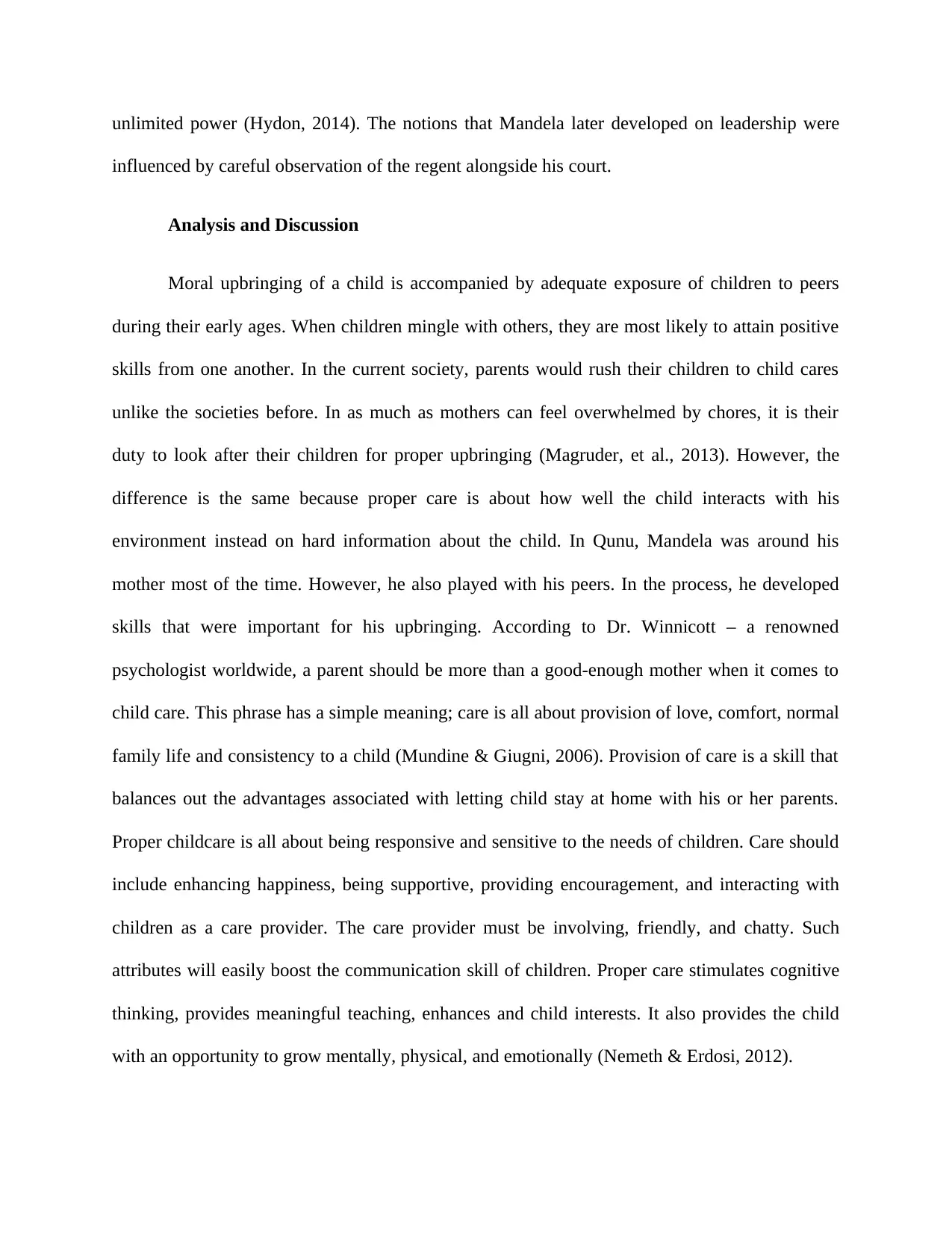
unlimited power (Hydon, 2014). The notions that Mandela later developed on leadership were
influenced by careful observation of the regent alongside his court.
Analysis and Discussion
Moral upbringing of a child is accompanied by adequate exposure of children to peers
during their early ages. When children mingle with others, they are most likely to attain positive
skills from one another. In the current society, parents would rush their children to child cares
unlike the societies before. In as much as mothers can feel overwhelmed by chores, it is their
duty to look after their children for proper upbringing (Magruder, et al., 2013). However, the
difference is the same because proper care is about how well the child interacts with his
environment instead on hard information about the child. In Qunu, Mandela was around his
mother most of the time. However, he also played with his peers. In the process, he developed
skills that were important for his upbringing. According to Dr. Winnicott – a renowned
psychologist worldwide, a parent should be more than a good-enough mother when it comes to
child care. This phrase has a simple meaning; care is all about provision of love, comfort, normal
family life and consistency to a child (Mundine & Giugni, 2006). Provision of care is a skill that
balances out the advantages associated with letting child stay at home with his or her parents.
Proper childcare is all about being responsive and sensitive to the needs of children. Care should
include enhancing happiness, being supportive, providing encouragement, and interacting with
children as a care provider. The care provider must be involving, friendly, and chatty. Such
attributes will easily boost the communication skill of children. Proper care stimulates cognitive
thinking, provides meaningful teaching, enhances and child interests. It also provides the child
with an opportunity to grow mentally, physical, and emotionally (Nemeth & Erdosi, 2012).
influenced by careful observation of the regent alongside his court.
Analysis and Discussion
Moral upbringing of a child is accompanied by adequate exposure of children to peers
during their early ages. When children mingle with others, they are most likely to attain positive
skills from one another. In the current society, parents would rush their children to child cares
unlike the societies before. In as much as mothers can feel overwhelmed by chores, it is their
duty to look after their children for proper upbringing (Magruder, et al., 2013). However, the
difference is the same because proper care is about how well the child interacts with his
environment instead on hard information about the child. In Qunu, Mandela was around his
mother most of the time. However, he also played with his peers. In the process, he developed
skills that were important for his upbringing. According to Dr. Winnicott – a renowned
psychologist worldwide, a parent should be more than a good-enough mother when it comes to
child care. This phrase has a simple meaning; care is all about provision of love, comfort, normal
family life and consistency to a child (Mundine & Giugni, 2006). Provision of care is a skill that
balances out the advantages associated with letting child stay at home with his or her parents.
Proper childcare is all about being responsive and sensitive to the needs of children. Care should
include enhancing happiness, being supportive, providing encouragement, and interacting with
children as a care provider. The care provider must be involving, friendly, and chatty. Such
attributes will easily boost the communication skill of children. Proper care stimulates cognitive
thinking, provides meaningful teaching, enhances and child interests. It also provides the child
with an opportunity to grow mentally, physical, and emotionally (Nemeth & Erdosi, 2012).
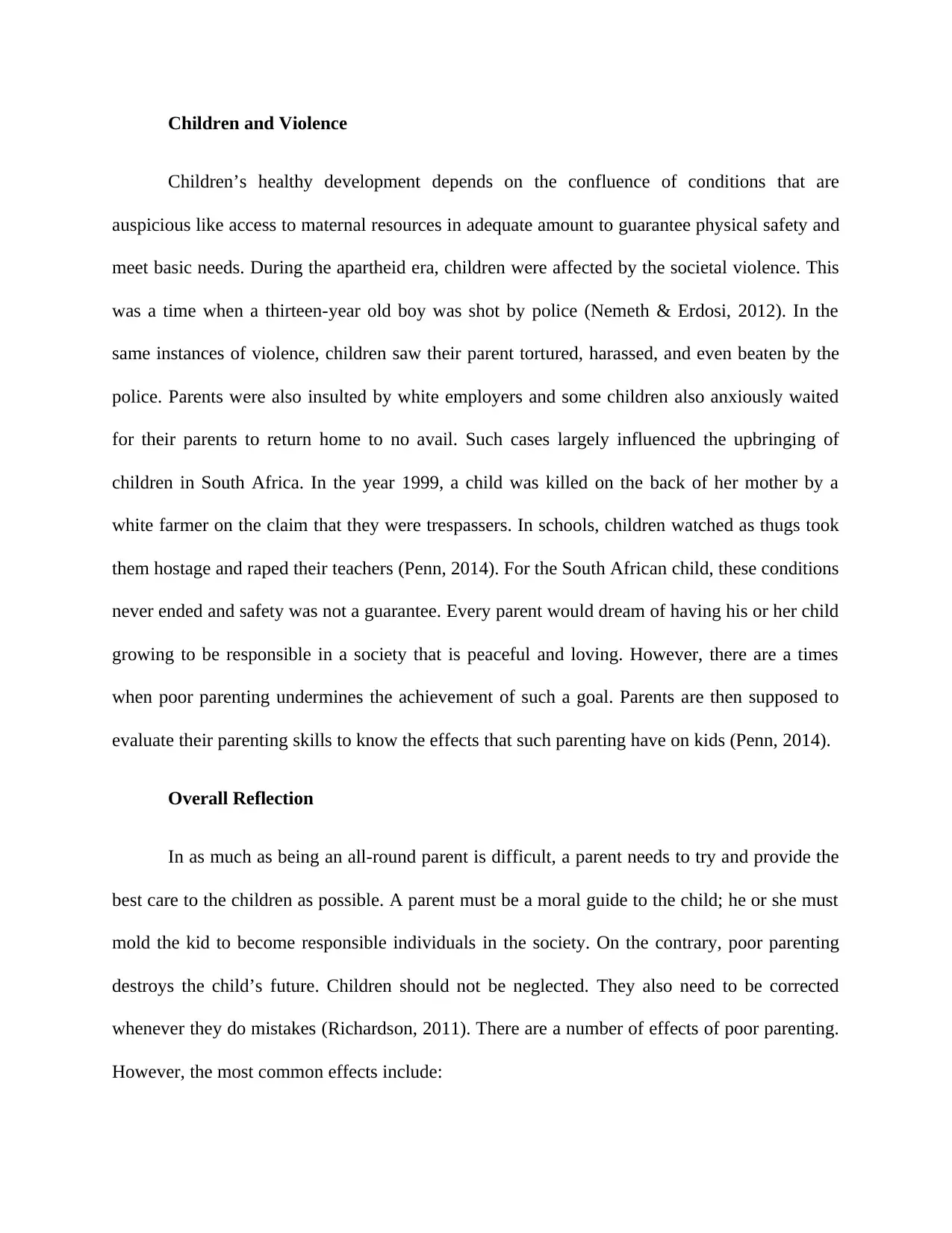
Children and Violence
Children’s healthy development depends on the confluence of conditions that are
auspicious like access to maternal resources in adequate amount to guarantee physical safety and
meet basic needs. During the apartheid era, children were affected by the societal violence. This
was a time when a thirteen-year old boy was shot by police (Nemeth & Erdosi, 2012). In the
same instances of violence, children saw their parent tortured, harassed, and even beaten by the
police. Parents were also insulted by white employers and some children also anxiously waited
for their parents to return home to no avail. Such cases largely influenced the upbringing of
children in South Africa. In the year 1999, a child was killed on the back of her mother by a
white farmer on the claim that they were trespassers. In schools, children watched as thugs took
them hostage and raped their teachers (Penn, 2014). For the South African child, these conditions
never ended and safety was not a guarantee. Every parent would dream of having his or her child
growing to be responsible in a society that is peaceful and loving. However, there are a times
when poor parenting undermines the achievement of such a goal. Parents are then supposed to
evaluate their parenting skills to know the effects that such parenting have on kids (Penn, 2014).
Overall Reflection
In as much as being an all-round parent is difficult, a parent needs to try and provide the
best care to the children as possible. A parent must be a moral guide to the child; he or she must
mold the kid to become responsible individuals in the society. On the contrary, poor parenting
destroys the child’s future. Children should not be neglected. They also need to be corrected
whenever they do mistakes (Richardson, 2011). There are a number of effects of poor parenting.
However, the most common effects include:
Children’s healthy development depends on the confluence of conditions that are
auspicious like access to maternal resources in adequate amount to guarantee physical safety and
meet basic needs. During the apartheid era, children were affected by the societal violence. This
was a time when a thirteen-year old boy was shot by police (Nemeth & Erdosi, 2012). In the
same instances of violence, children saw their parent tortured, harassed, and even beaten by the
police. Parents were also insulted by white employers and some children also anxiously waited
for their parents to return home to no avail. Such cases largely influenced the upbringing of
children in South Africa. In the year 1999, a child was killed on the back of her mother by a
white farmer on the claim that they were trespassers. In schools, children watched as thugs took
them hostage and raped their teachers (Penn, 2014). For the South African child, these conditions
never ended and safety was not a guarantee. Every parent would dream of having his or her child
growing to be responsible in a society that is peaceful and loving. However, there are a times
when poor parenting undermines the achievement of such a goal. Parents are then supposed to
evaluate their parenting skills to know the effects that such parenting have on kids (Penn, 2014).
Overall Reflection
In as much as being an all-round parent is difficult, a parent needs to try and provide the
best care to the children as possible. A parent must be a moral guide to the child; he or she must
mold the kid to become responsible individuals in the society. On the contrary, poor parenting
destroys the child’s future. Children should not be neglected. They also need to be corrected
whenever they do mistakes (Richardson, 2011). There are a number of effects of poor parenting.
However, the most common effects include:
⊘ This is a preview!⊘
Do you want full access?
Subscribe today to unlock all pages.

Trusted by 1+ million students worldwide
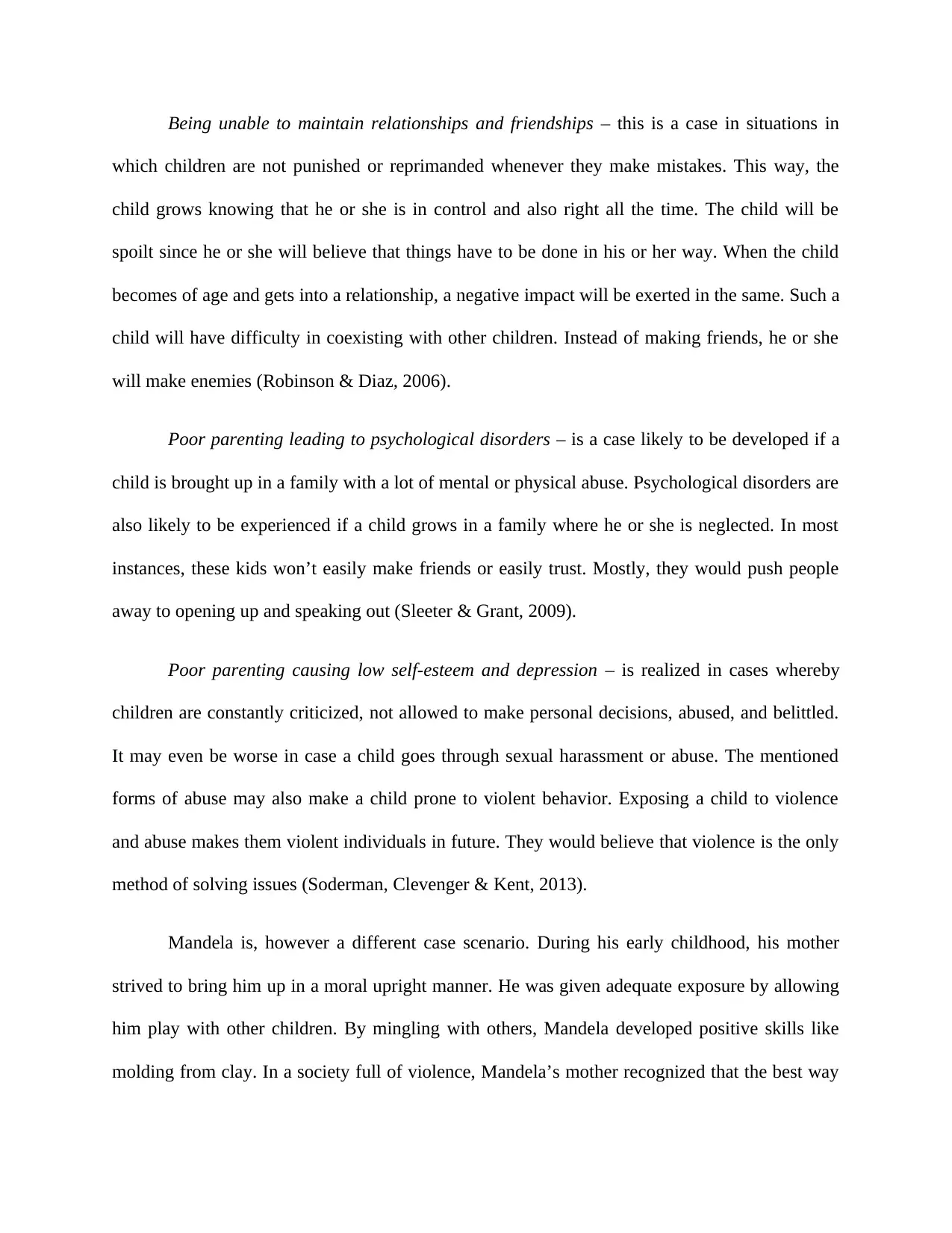
Being unable to maintain relationships and friendships – this is a case in situations in
which children are not punished or reprimanded whenever they make mistakes. This way, the
child grows knowing that he or she is in control and also right all the time. The child will be
spoilt since he or she will believe that things have to be done in his or her way. When the child
becomes of age and gets into a relationship, a negative impact will be exerted in the same. Such a
child will have difficulty in coexisting with other children. Instead of making friends, he or she
will make enemies (Robinson & Diaz, 2006).
Poor parenting leading to psychological disorders – is a case likely to be developed if a
child is brought up in a family with a lot of mental or physical abuse. Psychological disorders are
also likely to be experienced if a child grows in a family where he or she is neglected. In most
instances, these kids won’t easily make friends or easily trust. Mostly, they would push people
away to opening up and speaking out (Sleeter & Grant, 2009).
Poor parenting causing low self-esteem and depression – is realized in cases whereby
children are constantly criticized, not allowed to make personal decisions, abused, and belittled.
It may even be worse in case a child goes through sexual harassment or abuse. The mentioned
forms of abuse may also make a child prone to violent behavior. Exposing a child to violence
and abuse makes them violent individuals in future. They would believe that violence is the only
method of solving issues (Soderman, Clevenger & Kent, 2013).
Mandela is, however a different case scenario. During his early childhood, his mother
strived to bring him up in a moral upright manner. He was given adequate exposure by allowing
him play with other children. By mingling with others, Mandela developed positive skills like
molding from clay. In a society full of violence, Mandela’s mother recognized that the best way
which children are not punished or reprimanded whenever they make mistakes. This way, the
child grows knowing that he or she is in control and also right all the time. The child will be
spoilt since he or she will believe that things have to be done in his or her way. When the child
becomes of age and gets into a relationship, a negative impact will be exerted in the same. Such a
child will have difficulty in coexisting with other children. Instead of making friends, he or she
will make enemies (Robinson & Diaz, 2006).
Poor parenting leading to psychological disorders – is a case likely to be developed if a
child is brought up in a family with a lot of mental or physical abuse. Psychological disorders are
also likely to be experienced if a child grows in a family where he or she is neglected. In most
instances, these kids won’t easily make friends or easily trust. Mostly, they would push people
away to opening up and speaking out (Sleeter & Grant, 2009).
Poor parenting causing low self-esteem and depression – is realized in cases whereby
children are constantly criticized, not allowed to make personal decisions, abused, and belittled.
It may even be worse in case a child goes through sexual harassment or abuse. The mentioned
forms of abuse may also make a child prone to violent behavior. Exposing a child to violence
and abuse makes them violent individuals in future. They would believe that violence is the only
method of solving issues (Soderman, Clevenger & Kent, 2013).
Mandela is, however a different case scenario. During his early childhood, his mother
strived to bring him up in a moral upright manner. He was given adequate exposure by allowing
him play with other children. By mingling with others, Mandela developed positive skills like
molding from clay. In a society full of violence, Mandela’s mother recognized that the best way
Paraphrase This Document
Need a fresh take? Get an instant paraphrase of this document with our AI Paraphraser
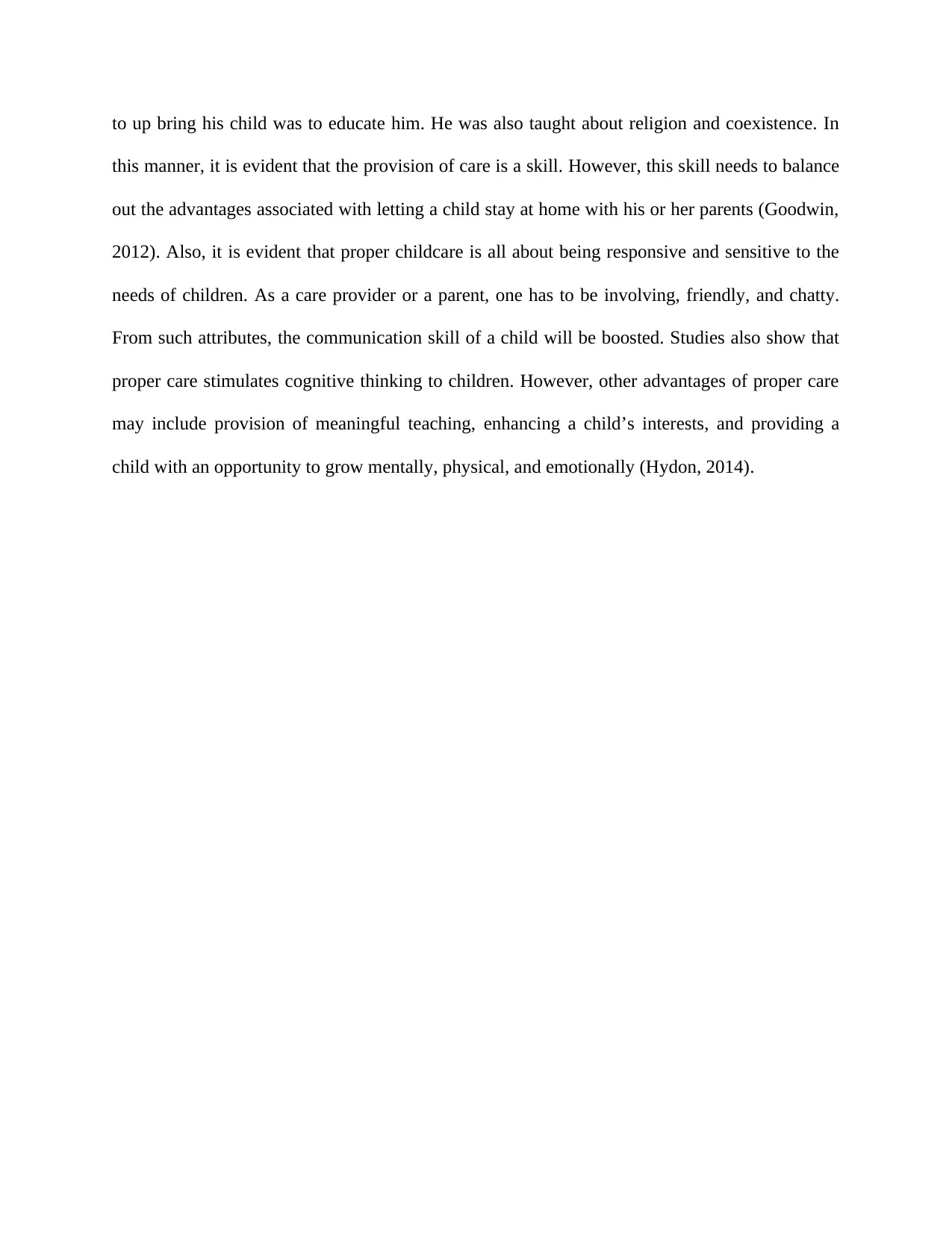
to up bring his child was to educate him. He was also taught about religion and coexistence. In
this manner, it is evident that the provision of care is a skill. However, this skill needs to balance
out the advantages associated with letting a child stay at home with his or her parents (Goodwin,
2012). Also, it is evident that proper childcare is all about being responsive and sensitive to the
needs of children. As a care provider or a parent, one has to be involving, friendly, and chatty.
From such attributes, the communication skill of a child will be boosted. Studies also show that
proper care stimulates cognitive thinking to children. However, other advantages of proper care
may include provision of meaningful teaching, enhancing a child’s interests, and providing a
child with an opportunity to grow mentally, physical, and emotionally (Hydon, 2014).
this manner, it is evident that the provision of care is a skill. However, this skill needs to balance
out the advantages associated with letting a child stay at home with his or her parents (Goodwin,
2012). Also, it is evident that proper childcare is all about being responsive and sensitive to the
needs of children. As a care provider or a parent, one has to be involving, friendly, and chatty.
From such attributes, the communication skill of a child will be boosted. Studies also show that
proper care stimulates cognitive thinking to children. However, other advantages of proper care
may include provision of meaningful teaching, enhancing a child’s interests, and providing a
child with an opportunity to grow mentally, physical, and emotionally (Hydon, 2014).
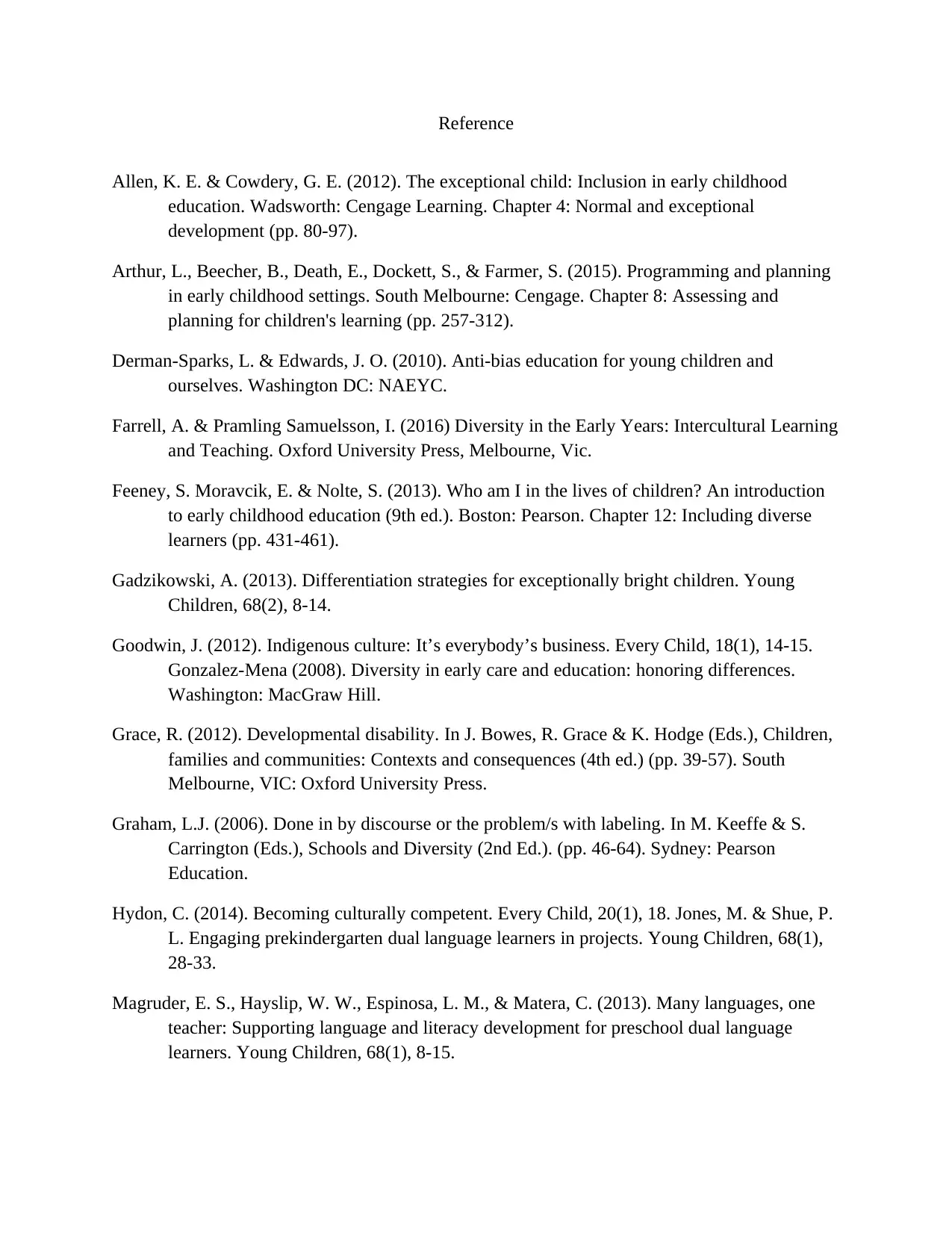
Reference
Allen, K. E. & Cowdery, G. E. (2012). The exceptional child: Inclusion in early childhood
education. Wadsworth: Cengage Learning. Chapter 4: Normal and exceptional
development (pp. 80-97).
Arthur, L., Beecher, B., Death, E., Dockett, S., & Farmer, S. (2015). Programming and planning
in early childhood settings. South Melbourne: Cengage. Chapter 8: Assessing and
planning for children's learning (pp. 257-312).
Derman-Sparks, L. & Edwards, J. O. (2010). Anti-bias education for young children and
ourselves. Washington DC: NAEYC.
Farrell, A. & Pramling Samuelsson, I. (2016) Diversity in the Early Years: Intercultural Learning
and Teaching. Oxford University Press, Melbourne, Vic.
Feeney, S. Moravcik, E. & Nolte, S. (2013). Who am I in the lives of children? An introduction
to early childhood education (9th ed.). Boston: Pearson. Chapter 12: Including diverse
learners (pp. 431-461).
Gadzikowski, A. (2013). Differentiation strategies for exceptionally bright children. Young
Children, 68(2), 8-14.
Goodwin, J. (2012). Indigenous culture: It’s everybody’s business. Every Child, 18(1), 14-15.
Gonzalez-Mena (2008). Diversity in early care and education: honoring differences.
Washington: MacGraw Hill.
Grace, R. (2012). Developmental disability. In J. Bowes, R. Grace & K. Hodge (Eds.), Children,
families and communities: Contexts and consequences (4th ed.) (pp. 39-57). South
Melbourne, VIC: Oxford University Press.
Graham, L.J. (2006). Done in by discourse or the problem/s with labeling. In M. Keeffe & S.
Carrington (Eds.), Schools and Diversity (2nd Ed.). (pp. 46-64). Sydney: Pearson
Education.
Hydon, C. (2014). Becoming culturally competent. Every Child, 20(1), 18. Jones, M. & Shue, P.
L. Engaging prekindergarten dual language learners in projects. Young Children, 68(1),
28-33.
Magruder, E. S., Hayslip, W. W., Espinosa, L. M., & Matera, C. (2013). Many languages, one
teacher: Supporting language and literacy development for preschool dual language
learners. Young Children, 68(1), 8-15.
Allen, K. E. & Cowdery, G. E. (2012). The exceptional child: Inclusion in early childhood
education. Wadsworth: Cengage Learning. Chapter 4: Normal and exceptional
development (pp. 80-97).
Arthur, L., Beecher, B., Death, E., Dockett, S., & Farmer, S. (2015). Programming and planning
in early childhood settings. South Melbourne: Cengage. Chapter 8: Assessing and
planning for children's learning (pp. 257-312).
Derman-Sparks, L. & Edwards, J. O. (2010). Anti-bias education for young children and
ourselves. Washington DC: NAEYC.
Farrell, A. & Pramling Samuelsson, I. (2016) Diversity in the Early Years: Intercultural Learning
and Teaching. Oxford University Press, Melbourne, Vic.
Feeney, S. Moravcik, E. & Nolte, S. (2013). Who am I in the lives of children? An introduction
to early childhood education (9th ed.). Boston: Pearson. Chapter 12: Including diverse
learners (pp. 431-461).
Gadzikowski, A. (2013). Differentiation strategies for exceptionally bright children. Young
Children, 68(2), 8-14.
Goodwin, J. (2012). Indigenous culture: It’s everybody’s business. Every Child, 18(1), 14-15.
Gonzalez-Mena (2008). Diversity in early care and education: honoring differences.
Washington: MacGraw Hill.
Grace, R. (2012). Developmental disability. In J. Bowes, R. Grace & K. Hodge (Eds.), Children,
families and communities: Contexts and consequences (4th ed.) (pp. 39-57). South
Melbourne, VIC: Oxford University Press.
Graham, L.J. (2006). Done in by discourse or the problem/s with labeling. In M. Keeffe & S.
Carrington (Eds.), Schools and Diversity (2nd Ed.). (pp. 46-64). Sydney: Pearson
Education.
Hydon, C. (2014). Becoming culturally competent. Every Child, 20(1), 18. Jones, M. & Shue, P.
L. Engaging prekindergarten dual language learners in projects. Young Children, 68(1),
28-33.
Magruder, E. S., Hayslip, W. W., Espinosa, L. M., & Matera, C. (2013). Many languages, one
teacher: Supporting language and literacy development for preschool dual language
learners. Young Children, 68(1), 8-15.
⊘ This is a preview!⊘
Do you want full access?
Subscribe today to unlock all pages.

Trusted by 1+ million students worldwide
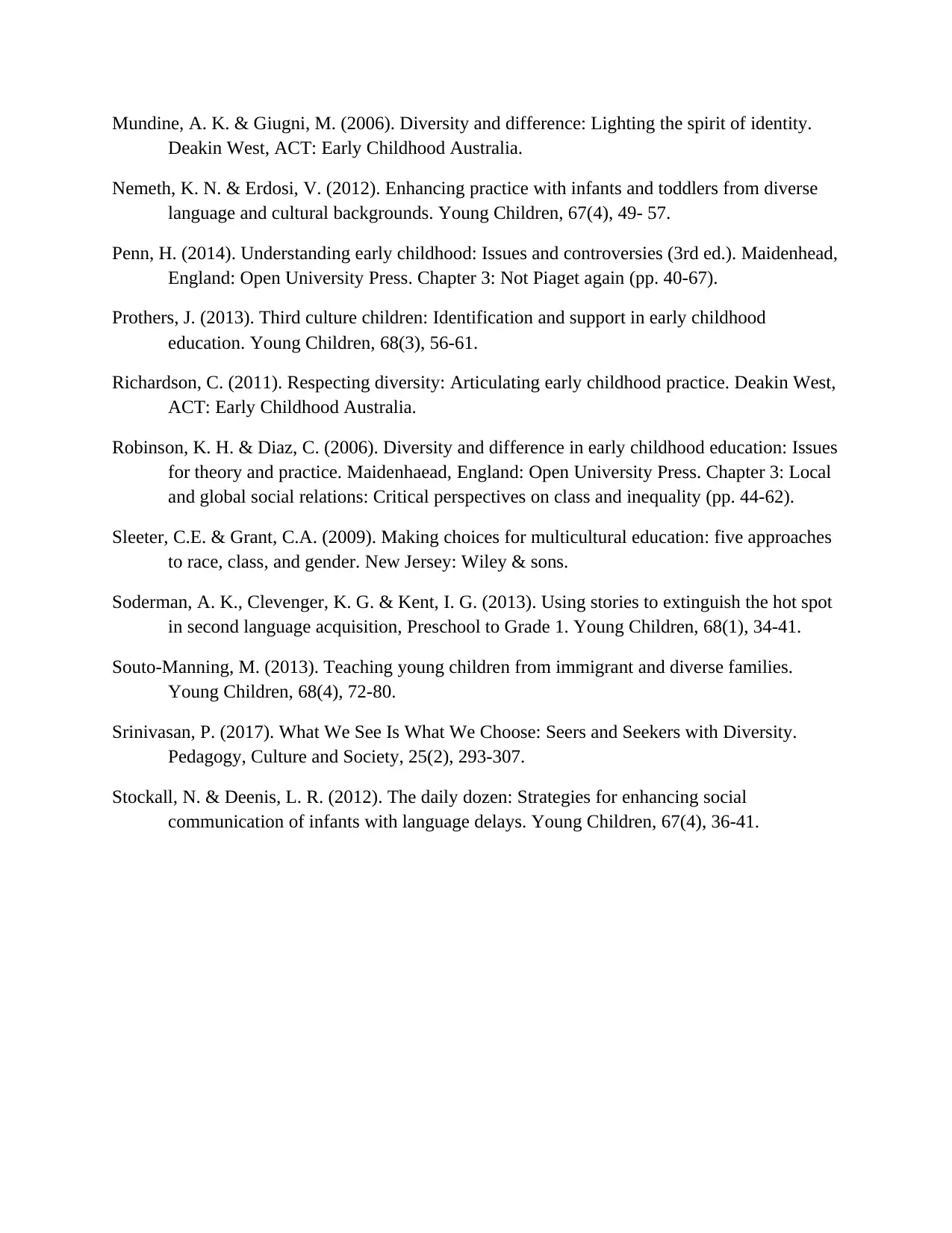
Mundine, A. K. & Giugni, M. (2006). Diversity and difference: Lighting the spirit of identity.
Deakin West, ACT: Early Childhood Australia.
Nemeth, K. N. & Erdosi, V. (2012). Enhancing practice with infants and toddlers from diverse
language and cultural backgrounds. Young Children, 67(4), 49- 57.
Penn, H. (2014). Understanding early childhood: Issues and controversies (3rd ed.). Maidenhead,
England: Open University Press. Chapter 3: Not Piaget again (pp. 40-67).
Prothers, J. (2013). Third culture children: Identification and support in early childhood
education. Young Children, 68(3), 56-61.
Richardson, C. (2011). Respecting diversity: Articulating early childhood practice. Deakin West,
ACT: Early Childhood Australia.
Robinson, K. H. & Diaz, C. (2006). Diversity and difference in early childhood education: Issues
for theory and practice. Maidenhaead, England: Open University Press. Chapter 3: Local
and global social relations: Critical perspectives on class and inequality (pp. 44-62).
Sleeter, C.E. & Grant, C.A. (2009). Making choices for multicultural education: five approaches
to race, class, and gender. New Jersey: Wiley & sons.
Soderman, A. K., Clevenger, K. G. & Kent, I. G. (2013). Using stories to extinguish the hot spot
in second language acquisition, Preschool to Grade 1. Young Children, 68(1), 34-41.
Souto-Manning, M. (2013). Teaching young children from immigrant and diverse families.
Young Children, 68(4), 72-80.
Srinivasan, P. (2017). What We See Is What We Choose: Seers and Seekers with Diversity.
Pedagogy, Culture and Society, 25(2), 293-307.
Stockall, N. & Deenis, L. R. (2012). The daily dozen: Strategies for enhancing social
communication of infants with language delays. Young Children, 67(4), 36-41.
Deakin West, ACT: Early Childhood Australia.
Nemeth, K. N. & Erdosi, V. (2012). Enhancing practice with infants and toddlers from diverse
language and cultural backgrounds. Young Children, 67(4), 49- 57.
Penn, H. (2014). Understanding early childhood: Issues and controversies (3rd ed.). Maidenhead,
England: Open University Press. Chapter 3: Not Piaget again (pp. 40-67).
Prothers, J. (2013). Third culture children: Identification and support in early childhood
education. Young Children, 68(3), 56-61.
Richardson, C. (2011). Respecting diversity: Articulating early childhood practice. Deakin West,
ACT: Early Childhood Australia.
Robinson, K. H. & Diaz, C. (2006). Diversity and difference in early childhood education: Issues
for theory and practice. Maidenhaead, England: Open University Press. Chapter 3: Local
and global social relations: Critical perspectives on class and inequality (pp. 44-62).
Sleeter, C.E. & Grant, C.A. (2009). Making choices for multicultural education: five approaches
to race, class, and gender. New Jersey: Wiley & sons.
Soderman, A. K., Clevenger, K. G. & Kent, I. G. (2013). Using stories to extinguish the hot spot
in second language acquisition, Preschool to Grade 1. Young Children, 68(1), 34-41.
Souto-Manning, M. (2013). Teaching young children from immigrant and diverse families.
Young Children, 68(4), 72-80.
Srinivasan, P. (2017). What We See Is What We Choose: Seers and Seekers with Diversity.
Pedagogy, Culture and Society, 25(2), 293-307.
Stockall, N. & Deenis, L. R. (2012). The daily dozen: Strategies for enhancing social
communication of infants with language delays. Young Children, 67(4), 36-41.
1 out of 10
Related Documents
Your All-in-One AI-Powered Toolkit for Academic Success.
+13062052269
info@desklib.com
Available 24*7 on WhatsApp / Email
![[object Object]](/_next/static/media/star-bottom.7253800d.svg)
Unlock your academic potential
Copyright © 2020–2025 A2Z Services. All Rights Reserved. Developed and managed by ZUCOL.



